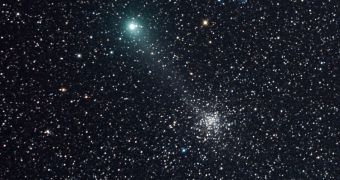After making a close pass through the inner solar system this March, comet Garradd – known among experts as C/2009 P1 – is now moving away from the Sun. The Swift Gamma-Ray Burst Mission is using one of its instruments to keep tabs on this weird object.
The thing that immediately attracted astronomers' attention to this comet is the fact that it appears to contain vast amounts of dust, a lot of which is being released as the object travels. Since these objects are rather rare, experts have a unique opportunity to study them.
Astronomers are especially interested in figuring out how the comet changes its behavior as it moves farther and farther away from the Sun. At this point, it is flying south, and can be seen on telescopes passing through the constellations Lynx and Ursa Major.
When it moved close to the Sun, the comet began releasing large amounts of dust and ice, in tune with how warm it got. The water left behind by the comet freezes due to the coldness of space, and remains frozen until it reaches a distance of 3 AU from the Sun.
An AU (astronomical unit) is the mean distance between the Earth and the Sun, or about 93 million miles (157 million kilometers). This threshold is referred to as the solar system's “snow line.”
“Comet Garradd was producing lots of dust and gas well before it reached the snow line, which tells us that the activity was powered by something other than water ice,” scientist Dennis Bodewits explains.
“We plan to use Swift’s unique capabilities to monitor Garradd as it moves beyond the snow line, where few comets are studied,” says the expert, who was the lead investigator on the new study. He is an assistant research scientist at the University of Maryland in College Park.
Swift, a telescope designed to locate and analyze gamma-ray bursts in the early Universe, is also capable of studying comets, by using its Ultraviolet/Optical Telescope (UVOT). This instrument is actually very well suited for such investigations, Astrobiology Magazine reports.
“Tracking the comet’s water and dust production and watching its chemistry change as it moves deeper into the Solar System will help us better understand how comets work and where they formed,” Swift team member and NASA Goddard Space Flight Center researcher, Stefan Immler, concludes.

 14 DAY TRIAL //
14 DAY TRIAL //